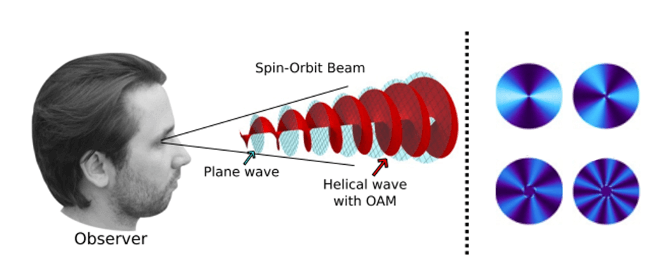Summary
Individual atoms can act as stationary qubits and thus serve as nodes in quantum computing networks or as memories for quantum repeaters. However, to successfully use qubits based on single atoms suspended in free space, photons emitted by a single atom need to be efficiently collected. Conventionally, this can be done with high numerical aperture lenses, which can collect light from a large solid angle. Alternatively, placing the atom into a high-finesse cavity or within a sub-wavelength distance from the surface of a nano-photonic structure can affect the spatial pattern in which the atom emits photons and make the photon collection more efficient. However, these approaches remain experimentally challenging and can limit the potential for realistic scalability.
This project aims to achieve a distinctly novel way to control the emission pattern of a single atom by placing the atom at a distance of a few wavelengths from a chiral metasurface — a phased two-dimensional array of nano-scale metallic antennas or dielectric scatterers. We design and fabricate bi- and multi-layer structures with properly tuned interference between the radiation patterns of the layers. In the vicinity of such structures, the atom will emit light into a single, well defined direction without the need to place the atom at a sub-wavelength distance from a metallic or dielectric surface. The unidirectionally emitted photons can be efficiently coupled into optical fibers. Relative to current state-of-the-art, this platform simplifies and enables speed-up for certain quantum information processing tasks, such as remote entanglement between two distant atoms.
Simultaneously we will explore – through design and fabrication – the use of chiral metasurfaces for photon extraction from solid-state quantum emitters, such as colour centers in diamond. Here we hope to achieve increased photon collection efficiency from materials with high refractive index, which holds promise for improving the performance (speed and sensitivity) of electric and magnetic field sensors.

Figure 1. The spatial emission pattern of an atom suspended above the tip of an optical fibre is controlled by the two-layer metasurface mounted on the fiber tip. This allows efficient collection of the photons emitted by the atom and their coupling into the fibre.
Related Content

Hybrid Quantum Repeater based on Atomic Quantum Memories and Telecom Wavelength Entangled Photon-Pairs Generated from Semiconductor Nanowires
Summary Losses in physical channels, such as optical fibres, limit existing quantum communication systems to modest distance ranges. Since amplification of quantum signals is fundamentally not possible, we look to extend the range and functionality of these quantum channels by adding quantum memory nodes that can daisy-chain multiple lengths of quantum channels through entanglement […]
October 29, 2018

Structured Light Applications in Vision Science
Eye diseases such as macular degeneration can have a devastating impact on quality of life. Early detection and treatment are thus crucial for preventing irreversible vision loss. A previous study found that the human eye can detect differences in ‘structured’ light beams. Such light beams are composed of a coherent superposition of differently polarized planar […]
April 24, 2023
Folk Understanding of Quantum Physics
Summary It is often said that quantum concepts are counterintuitive. However, quantum concepts may not be equally counterintuitive to people from all cultural backgrounds. As cultural psychologists have discovered, culture fundamentally shapes the way people make sense of the world. In particular, the last few decades of research have documented cultural differences in appreciation of […]
March 24, 2021

Micro-Supercapacitors Based on Termination Optimized MXene Quantum Dots with Ultra-High Rate Capability and Fast Frequency Response
Micro-supercapacitors (MCs) are miniaturized energy storage devices that can enhance the performance of wearable health devices, medical implants, wireless sensors, and micro-electromechanical systems due to their fast frequency response, long life cycle, and vast temperature operation. However, to make these MC systems into commercially feasible products, necessary improvements to current MC performance are necessary, primarily […]
June 12, 2023

